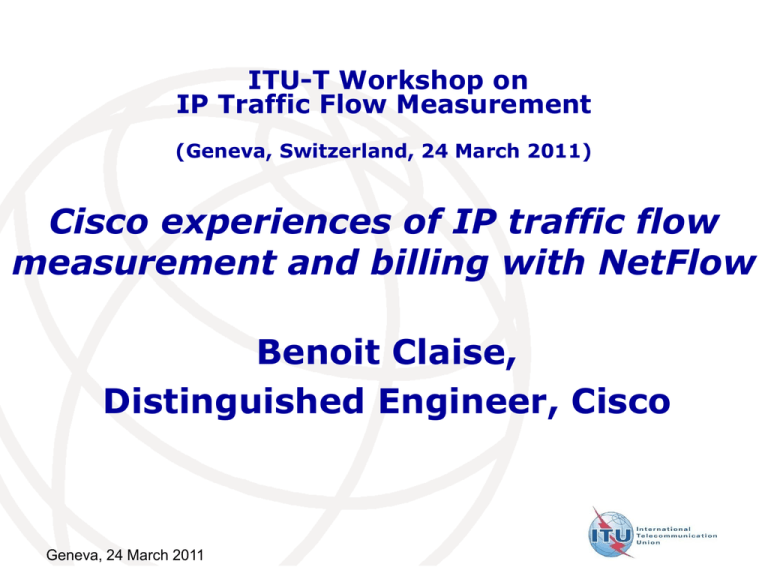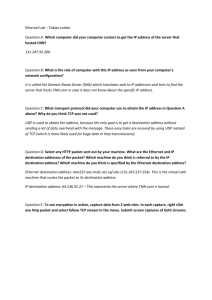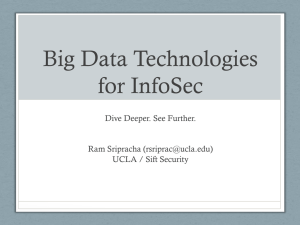Cisco experiences of IP traffic flow measurement and billing with NetFlow
advertisement

ITU-T Workshop on IP Traffic Flow Measurement (Geneva, Switzerland, 24 March 2011) Cisco experiences of IP traffic flow measurement and billing with NetFlow Benoit Claise, Distinguished Engineer, Cisco Geneva, 24 March 2011 What is NetFlow? NetFlow Records export Cache Collector Over UDP or SCTP Traffic What is NetFlow? NetFlow is used for traffic monitoring, security analysis, capacity planning and billing Billing is just a few % of our customers, mainly for charge back within enterprise network (not between service providers) NetFlow = a exporting protocol: NetFlow v5, 7, 8, 9 (RFC3954), and IPFIX (RFC5101/RFC5102) NetFlow v9 and IPFIX work with a template based mechanism Advantage: extensibility, just need to add new Information Element NetFlow = a metering process: Flexible NetFlow Advantages: cache and export content flexibility User selection of flow keys User definition of the records Flexible NetFlow: Potential Key Fields Flow IPv4 Sampler ID IP (Source or Destination) Payload Size IP (Source or Destination) Payload Size Prefix (Source or Destination) Packet Section (Header) Prefix (Source or Destination) Packet Section (Header) Mask (Source or Destination) Packet Section (Payload) Mask (Source or Destination) Packet Section (Payload) Minimum-Mask (Source or Destination) TTL Minimum-Mask (Source or Destination) DSCP Dest VLAN Protocol Options bitmap Protocol Extension Headers Dot1q VLAN Fragmentation Flags Version Traffic Class Hop-Limit Dot1q priority Fragmentation Offset Precedence Flow Label Length Option Header Next-header Identification DSCP Header Length TOS Header Length Version Direction Interface Input Output Layer 2 Source VLAN Source MAC address Destination MAC address Total Length IPv6 Payload Length Flexible NetFlow: Potential Key Fields Routing Transport src or dest AS Destination Port TCP Flag: ACK Peer AS Source Port TCP Flag: CWR Traffic Index ICMP Code TCP Flag: ECE Forwarding Status ICMP Type TCP Flag: FIN IGMP Type* TCP Flag: PSH TCP ACK Number TCP Flag: RST TCP Header Length TCP Flag: SYN TCP Sequence Number TCP Flag: URG IGP Next Hop BGP Next Hop Input VRF Name Application Application ID* Multicast Replication Factor* RPF Check Drop* Is-Multicast TCP Window-Size UDP Message Length TCP Source Port UDP Source Port TCP Destination Port UDP Destination Port TCP Urgent Pointer *: IPv4 Flow only Flexible NetFlow: Potential Non-Key Fields Counters Timestamp IPv4 IPv4 and IPv6 Bytes sysUpTime First Packet Total Length Minimum (*) Total Length Minimum (**) Bytes Long sysUpTime First Packet Total Length Maximum (*) Total Length Maximum (**) Bytes Square Sum TTL Minimum Bytes Square Sum Long TTL Maximum Packets Packets Long Plus any of the potential “key” fields: will be the value from the first packet in the flow (*) IPV4_TOTAL_LEN_MIN, IPV4_TOTAL_LEN_MAX (**)IP_LENGTH_TOTAL_MIN, IP_LENGTH_TOTAL_MAX Performance Limited Resources in Router Don’t enable all flow keys The routers still have to route packets NetFlow for Billing: Experience Issue: Can we use Sampled NetFlow for billing? Estimation Accuracy (PLT_NZIX1, S24D00, Cisco, f=5% #Packets Nf Huge amount of data, must sometimes deal with sampled NetFlow, i.e. 1 out of N packets, depending on the platform Packet Sampling for Flow Accounting: Challenges and Limitations, Tanja Zseby, Thomas Hirsch, Benoit Claise, PAM 2008 Mean Packet Size µf Issue: Can we use Sampled NetFlow for billing? Square sum of bytes available in Flexible NetFlow Not used in practice, not even by the collectors! Customers afraid of legal issues with sampling along with a billing service Destination Sensitive Billing Proposal (many years ago) 1. BGP routing updates 2. Go through a table-map statement 3. table-map calls a route-map Customer AS 192 I-BGP Forwarding Information Base Prefix AS=196 prefix one prefix two Traffic-index E-BGP traffic trafficindex index==11 traffic index = 2 ISP 1 $5.00 per 100 MB 4. route-map’s criteria: if criteria 1 -> traffic-index = 1 if criteria 2 -> traffic-index = 2 E-BGP Accounting AS=193 ISP 2 $7.00 per 100 MB BGP Policy Accounting Principles Allows to classify packets based on IP access lists, BGP community list to characterize the exit points, where each exit point would set an specific community BGP AS paths Issue: What about the Returning Packets? The Customer FTP Request The ISP ISP 1 $5.00 per 100 MB Who should pay for the 100 MB back? Destination Sensitive Billing requires also source lookup (Source Sensitive Billing) 100 MB back ISP 2 $7.00 per 100 MB Issue: What about the Returning Packets? The Customer FTP Request The ISP ISP 1 $5.00 per 100 MB Lookup: • On the outgoing packets (on the packets coming back) • On the source • Same selection criteria 100 MB back ISP 2 $7.00 per 100 MB Issue: BGP Asymmetry Problem The Customer in Europe FTP Request Will charge the 10 Meg as if they were directly coming from the US!!! The ISP ISP 1 in Asia ISP 2 in US 100 MB back Issue: BGP Asymmetry Problem The source lookup is based on the route the router would take to reach the source! Too Many Issues Destination Sensitive Billing requires Source Sensitive Billing BGP asymmetry problem Only the traffic following the BGP routes will be accounted What if local policies outside of BGP? Limited amount of buckets in the Destination Sensitive Billing Doesn’t scale: too many entries Performance issues Entire NMS solution to be put in place Destination Sensitive Billing Conclusion/feedback from customers: too many issues not realistically deployable -> back to some sort of flat rate Benoit’s concern: If we bill per AS-PATH and each AS get a piece of the pie, people will create new AS and try to attract traffic Bad for the internet performance ITU-T Workshop on IP Traffic Flow Measurement (Geneva, Switzerland, 24 March 2011) Cisco experiences of IP traffic flow measurement and billing with NetFlow Benoit Claise, Distinguished Engineer, Cisco Geneva, 24 March 2011





